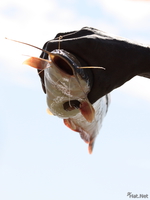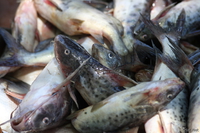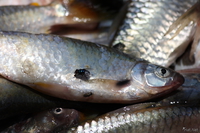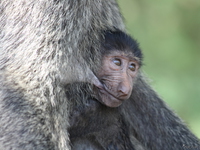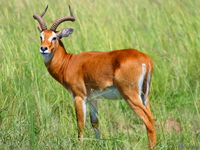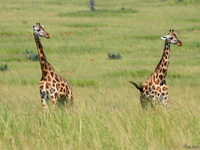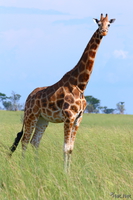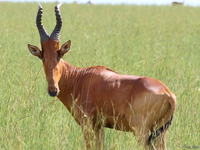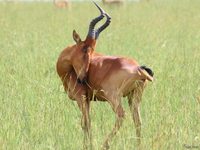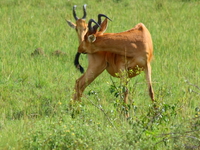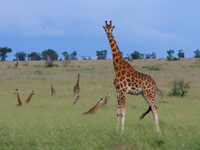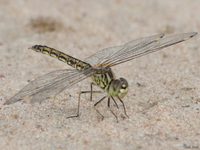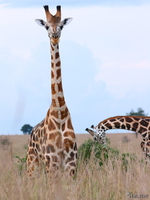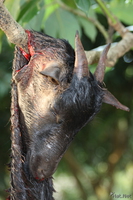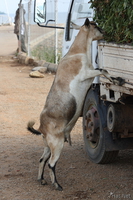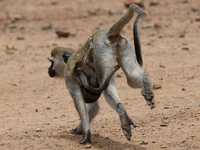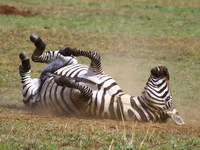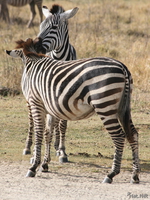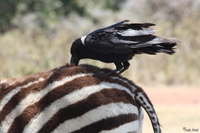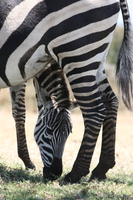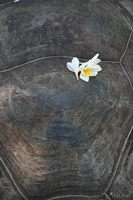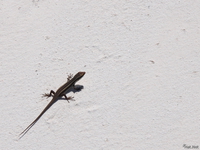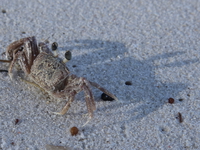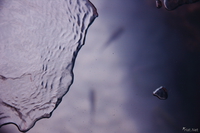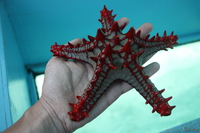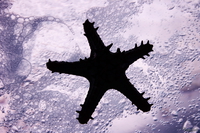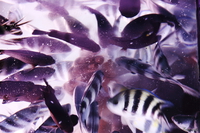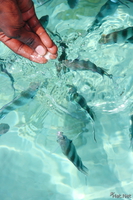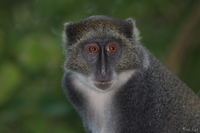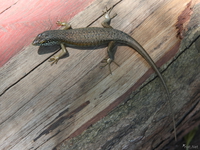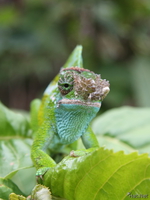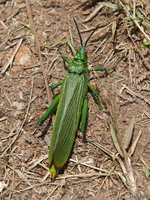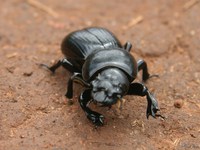harmless animals
Catfish (order Siluriformes) are a very diverse group of bony fish. Named for their prominent barbels, which give the image of cat-like whiskers, catfish range in size and behavior from the heaviest, the Mekong giant catfish in Southeast Asia and the longest, the wels catfish of Eurasia, to detritivores (species that eat dead material on the bottom), and even to a tiny parasitic species commonly called the candiru, Vandellia cirrhosa. There are armour-plated types and also naked types, neither having scales. Despite their common name, not all catfish have prominent barbels; what defines a fish as being in the order Siluriformes are in fact certain features of the skull and swimbladder. Catfish are of considerable commercial importance; many of the larger species are farmed or fished for food, and some are exploited for sport fishing, including a kind known as noodling. Many of the smaller species, particularly the genus Corydoras, are important in the aquarium hobby.
Female baboons typically give birth every other year, usually to a single infant, after a six month gestation. The young baboon weighs approximately one kilogram and is colored black. The females tend to be the primary caretaker of the young, although several females will share the duties for all of their offspring.
The Ugandan Kob (Kobus kob thomasi, rarely Kobus kob thomasi neumann) is a sub-species of the kob, a type of antelope found in sub-Saharan Africa. It is normally reddish-brown, in which it differs from other kob sub-species. A Ugandan Kob appears on the coat of arms of Uganda.
The Ugandan Kob is sometimes alternatively classified into the sub-genus Adenota. References are sometimes made to it by the Dutch name of Oeganda-waterbok.
Romeo and Juliet is an early tragedy by William Shakespeare about two teenage "star-cross'd lovers" whose "untimely deaths" ultimately unite their feuding households. The play has been highly praised by literary critics for its language and dramatic effect. It was among Shakespeare's most popular plays during his lifetime and, along with Hamlet, is one of his most frequently performed plays. Romeo and Juliet are widely represented as archetypal young lovers.
And no, these two giraffes didn't kill themselves (I hope not), they are just hopelessly in love.
The Rothschild Giraffe, named after Tring Zoological Museum's founder, Lord Walter Rothschild, also known as the Baringo Giraffe, after the Lake Baringo area of Kenya, or as the Ugandan Giraffe, is the most endangered of giraffe subspecies, with around forty believed to exist in the wild. While giraffes in general are classified as Lower Risk: Conservation Dependent, the Rothschild Giraffe is at particular risk of hybridisation, as the population is so limited in numbers. There are very few locations where the Rothschild Giraffe can be seen in the wild, with notable spots being Lake Nakuru National Park in Kenya and Murchison Falls National Park in Northern Uganda. There are various captive breeding programmes in place - most notably at The Giraffe Centre in Nairobi, Kenya, and at Woburn Safari Park in Bedfordshire, England - which aim to expand the genetic gene-pool in the wild population of the Rothschild Giraffe.
The Hartebeest (Alcelaphus buselaphus) is a grassland antelope found in West Africa, East Africa and Southern Africa. It is the only animal classified in the genus Alcelaphus.
The Hartebeest stands almost 1.5 m (5 ft) at the shoulder and weighs anywhere from 120-200 kg (265-440 lb). Male Hartebeest are a dark brown colour while females are yellow brown. Both sexes have horns which can reach lengths up to 70 cm (27 in). Hartebeest live in grassland and open forest where they eat grass. They are diurnal and spend the morning and late afternoon eating. Herds contain five to twenty individuals but can occasionally contain up to three hundred and fifty.
The word hartebeest comes from Afrikaans and was originally called hertebeest. The name was given by the Boers who thought it resembled deer (hert in Dutch).
Female giraffes associate in groups of a dozen or so members, occasionally including a few younger males. Males tend to live in "bachelor" herds, with older males often leading solitary lives. Reproduction is polygamous, with a few older males impregnating all the fertile females in a herd. Male giraffes determine female fertility by tasting the female's urine in order to detect estrus, in a multi-step process known as the flehmen response.
Giraffes will mingle with the other herbivores in the African bush. They are beneficial to be around because of their height. A giraffe is tall enough to have a much wider scope of an area and will watch out for predators.
Female dragonflies lay eggs in or near water, often on floating or emergent plants. When laying eggs, some species will submerge themselves completely in order to lay their eggs on a suitable surface. Most of a dragonfly's life is spent in the larval, (naiad, aka nymph) form, beneath the water's surface, using internal gills to breathe, and using extendable jaws to catch other invertebrates or even vertebrates such as tadpoles and fish. The larval stage of large dragonflies may last as long as five years. In smaller species, this stage may last between two months and three years. When the larva is ready to metamorphose into an adult, it climbs up a reed or other emergent plant at night. Exposure to air causes the larva to begin breathing. The skin splits at a weak spot behind the head and the adult dragonfly crawls out of its old larval skin, waits for the sun to rise, pumps up its wings and flies off to feed on midges and flies. The adult stage of larger species of dragonfly can last as long as four months.
Rothschild Giraffes are easily distinguishable from other subspecies. The most obvious visible sign is in the colouring of the coat, or pelt. Where the Reticulated Giraffe has very clearly defined dark patches with bright whitish channels between them, the Rothschild Giraffe more closely resembles the Masai Giraffe. However, when compared to the Masai Giraffe, the Rothschild subspecies is paler, the orange-brown patches are less jagged and sharp in shape and the connective channel is of a creamier hue compared to that oft sported by the Reticulated Giraffe. In addition, the Rothschild Giraffe displays no markings on the lower leg, giving the impression that it is wearing white stockings.
Goats do not usually consume garbage, tin cans, or clothing, although they will occasionally eat items made primarily of plant material, which can include wood. They have an intensely inquisitive and intelligent nature: they will explore anything new or unfamiliar in their surroundings. They do so primarily with their prehensile upper lip and tongue. This is why they investigate items such as buttons, camera cases or clothing (and many other things besides) by nibbling at them, occasionally even eating them.
The digestive physiology of a very young kid (like the young of other ruminants) is essentially the same as that of a monogastric animal. Milk digestion begins in the abomasum, the milk having bypassed the rumen via closure of the reticular/esophageal groove during suckling. At birth the rumen is undeveloped, but as the kid begins to consume solid feed, the rumen soon increases in size and in its capacity to absorb nutrients.
Geckos come in various colors and patterns. Some are subtly patterned, and somewhat rubbery looking, while others can be brightly colored . Some species can change color to blend in with their surroundings or with temperature differences. Some species are parthenogenic, the females capable of reproducing without copulating with a male. This improves the gecko's ability to spread to new islands.
The toes of the gecko have attracted a lot of attention, as they adhere to a wide variety of surfaces, without the use of liquids or surface tension. Recent studies of the spatula tipped setae on gecko footpads demonstrate that the attractive forces that hold geckos to surfaces are van der Waals interactions between the finely divided setae (almost 500,000 setae on each foot, and each of these tipped with between 100 and 1,000 spatulae) and the surfaces themselves. The length of each seta is twice the diameter of a human hair, i.e 100 millionth of meter and each spatulae is 200 billionth of meter long just below wavelength of visible light. These kinds of interactions involve no fluids; in theory, a boot made of synthetic setae would adhere as easily to the surface of the International Space Station as it would to a living room wall, although adhesion varies with humidity and is dramatically reduced under water, suggesting a contribution from capillarity. The setae on the feet of geckos are also self cleaning and will usually remove any clogging dirt within a few steps.
True crabs have five pairs of legs, the first of which are modified into a pair of claws and are not used for locomotion. In all but a few crabs (for example, Raninoida), the abdomen is folded under the cephalothorax in the adult stage. The mouthparts of crabs are covered by flattened maxillipeds, and the front of the carapace does not form a long rostrum. The gills of crabs are formed of flattened plates ("phyllobranchiate"), resembling those of shrimp, but of a different structure. They can also be the size of a pea, or even smaller.
Starfish or sea stars are any echinoderms belonging to the class Asteroidea. The names sea star and starfish are also (incorrectly) used for the closely related brittle stars, which make up the class Ophiuroidea.
Starfish exhibit a superficially radial symmetry. They typically have five or more "arms" which radiate from an indistinct disk (pentaradial symmetry). However, the evolutionary ancestors of echinoderms are believed to have had bilateral symmetry. Starfish do exhibit some superficial remnant of this body structure, evident in their larval pluteus forms.
Starfish do not rely on a jointed, movable skeleton for support and locomotion (although they are protected by their skeleton), but instead possess a hydraulic water vascular system that aids in locomotion. The water vascular system has many projections called tube feet on the ventral face of the starfish's arms which function in locomotion and aid with feeding.
The star fish usually hunt for shelled animals such as oysters and clams. They have two stomachs. One stomach is used for digestion, and the other stomach can be extended outward to engulf and digest prey. This feature allows the starfish to hunt prey that is much larger than its mouth would otherwise allow. Starfish are able to regenerate lost arms. A new starfish may be regenerated from a single arm attached to a portion of the central disk.
Starfish are composed of a central disc from which arms sprout in pentaradial symmetry. Most starfish have 5 arms, but some have more or fewer. Some starfish have shown differing numbers of limbs within a single species. The mouth is located underneath the starfish, on its ventral surface. The spiny upper surface is called the aboral or dorsal surface. On the aboral surface there is a structure called the madreporite, a small white spot located slightly off-center on the central disc which acts as a water filter and supplies the starfish's water vascular system with water to move. Porcellanasteridae employ additional cribriform organs used to generate current in the burrows made by these infaunal starfish.
While having their own basic body plan, starfish radiate diversely in shapes and colors, the morphology differing between each species. A starfish may have dense rows of spines as a means of protection, or it may have no spines at all. Ranging from nearly pentagonal (example: Indo-pacific cushion star, Culcita novaeguineae) to gracile stars like those of the Zoroaster genus.
Surrounding the spines on the surface of the starfish are small white objects known as pedicellariae. There are large numbers of these pedicellariae on the external body which serve to prevent encrusting organisms from colonizing the starfish. The radial canal which is across each arm of the starfish has tooth-like structures called ampullae, which surround the radial canal.
On the end of each arm or ray there is a microscopic eye which allows the starfish to see, although it only allows it to see light and dark, which is useful to see movement.
Patterns including mosaic-like tiles formed by ossicles, stripes, interconnecting net between spines, pustules with bright colors, mottles or spots. These mainly serve as camouflage or warning coloration which is displayed by many marine animals as a means of protection against predation. Several types of toxins and secondary metabolites have been extracted from several species of starfish. Research into the efficacy of these compounds for possible pharmacological or industrial use occurs worldwide.
The zebrafish or zebra danio, Danio rerio, is a tropical fish belonging to the minnow family (Cyprinidae). It is a popular aquarium fish, frequently sold under the trade name zebra danio, and is also an important model organism in scientific research.
The current mascot of SUSE Linux distribution is a gecko called Geeko, also known as the "SUSE Lizard", but is a Chameleon for the shape.
Grasshoppers have antennae that are almost always shorter than the body (sometimes filamentous), and short ovipositors. Those species that make easily heard noises usually do so by rubbing the hind femurs against the forewings or abdomen (stridulation), or by snapping the wings in flight. Tympana, if present, are on the sides of the first abdominal segment. The hind femora are typically long and strong, fitted for leaping. Generally they are winged, but hind wings are membranous while front wings (tegmina) are coriaceous and not fit for flight. Females are normally larger than males, with short ovipositors.
They are easily confused with the other sub-order of Orthoptera, Ensifera, but are different in many aspects, such as the number of segments in their antennae and structure of the ovipositor, as well as the location of the tympana and modes of sound production. Ensiferans have antennae with at least 30 segments, and caeliferans have fewer. In evolutionary terms, the split between the Caelifera and the Ensifera is no more recent than the Permo-Triassic boundary (Zeuner 1939).
Dung beetles (also known as tumble bugs) are beetles which feed partly or exclusively on feces. All of these species belong to the superfamily Scarabaeoidea; most of them to the subfamilies Scarabaeinae and Aphodiinae of the family Scarabaeidae. As most species of Scarabaeinae feed exclusively on feces, that subfamily is often dubbed true dung beetles. There are dung-feeding beetles which belong to other families, such as the Geotrupidae (the earth-boring dung beetle). The Scarabaeinae alone comprises more than 5,000 species.
Many dung beetles, known as rollers, are noted for rolling dung into spherical balls, which are used as a food source or brooding chambers. Other dung beetles, known as tunnellers, bury the dung wherever they find it. A third group, the dwellers, neither roll nor burrow: they simply live in manure.

